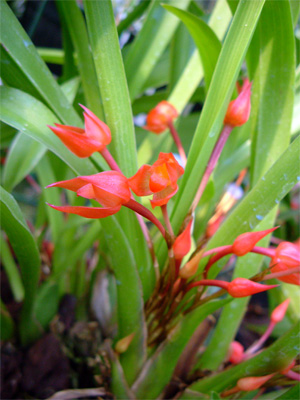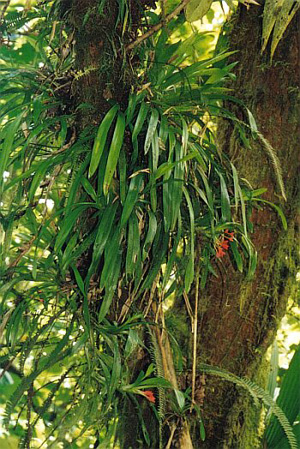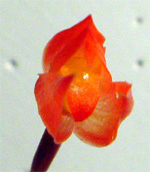Il genere Maxillaria non finisce mai di stupire.
Le oltre 700 specie del genere Maxillaria, diffuse nell’America Centrale, dal Messico al Venezuela e nord dell’Argentina, isole caraibiche comprese, sono quasi tutte specie epifite e prediligono generalmente zone montagnose tra i 400 e i 2.500 metri d’altitudine, poche specie vivono in località pianeggianti.
tutti i diritti sono riservati
 Maxillaria coccinea (Plum) L.O.Williams 1954
Maxillaria coccinea (Plum) L.O.Williams 1954
Nome comune: Maxillaria scarlatta o orchidea “fiamma”.
Sinonimi: Camaridium coccineum (Plum.) Hoehne 1947 – Cymbidium coccineum (Plum.) Willd. 1799 – Epidendrum coccineum (Plum) Jacq. 1760 –Helleborine coccinea multiflora Plum 1703 – Ornithidium acaule Hoffmsg. 1843 – Ornithidium coccineum (Plum.) Salisb. 1812
Questa specie frondosa e dal portamento elegante è un’orchidea epifita di medie dimensioni.
Vive in vari paesi del centro – sud America (Colombia, Venezuela ecc.).
Come tante altre specie, la Maxillaria coccinea predilige temperature da serra intermedia-fresca con buona aerazione
 La Maxillaria coccinea si sviluppa in forma simpodiale e produce pseudobulbi con una sola foglia apicale, flessibile e di lunghezza variabile (in sito 8-10 centimetri, in coltivazione può raggiungere anche i 20 centimetri); i fiori si presentano all’inizio della primavera in piccoli gruppi al piede delle nuove vegetazioni avvolte da piccole foglie secondarie e sono di colore rosso scarlatto (esiste anche la forma alba).
La Maxillaria coccinea si sviluppa in forma simpodiale e produce pseudobulbi con una sola foglia apicale, flessibile e di lunghezza variabile (in sito 8-10 centimetri, in coltivazione può raggiungere anche i 20 centimetri); i fiori si presentano all’inizio della primavera in piccoli gruppi al piede delle nuove vegetazioni avvolte da piccole foglie secondarie e sono di colore rosso scarlatto (esiste anche la forma alba).
Questa orchidea non richiede riposo invernale (come per tutte le orchidee, durante la stagione fredda vanno rallentate sia bagnature che concimazioni) e va bagnata con regolarità, tenuto conto di lasciarla asciugare fra una bagnatura e l’altra.
Concimate ad intervalli di tre settimane in estate e mensili nei mesi freddi con concime 20.20.20 a dosi ridotte ( 0,5 grammi di concime solubile x litro d’acqua.
Coltivate questa bella orchidea, nella parte luminosa della serra (luce del sole filtrata da leggera ombreggiatura estiva).
Note: un gruppo di botanici, ha studiato la struttura del fiore della Maxillaria coccinea ed in particolar modo le sue modalità di secrezione del nettare, riporto integralmente il loro lavoro:
 Nectary Structure and Nectar Secretion in Maxillaria coccinea (Jacq.) L.O. Williams ex Hodge (Orchidaceae)
Nectary Structure and Nectar Secretion in Maxillaria coccinea (Jacq.) L.O. Williams ex Hodge (Orchidaceae)M. STPICZY SKA1, K. L. DAVIES*,2 and A. GREGG3
1 Department of Botany, Agricultural University, Akademicka 15, 20-950 Lublin, Poland, 2 Department of Earth Sciences, Cardiff University, PO Box 914, Cardiff CF10 3YE, UK and 3 Swansea Botanical Complex, Singleton Park, Swansea SA2 9DU, UK
* For correspondence.
Received: 22 July 2003; Returned for revision: 1 September 2003; Accepted: 22 September 2003 Published electronically: 20 November 2003
• Background and Aims It had previously been assumed that Maxillaria spp. produce no nectar. However, nectar has recently been observed in Maxillaria coccinea (Jacq.) L.O. Williams ex Hodge amongst other species. Furthermore, it is speculated that M. coccinea may be pollinated by hummingbirds. The aim of this paper is to investigate these claims further.
• Methods Light microscopy, histochemistry, scanning and transmission electron microscopy.
• Key Results This is the first detailed account of nectar secretion in Maxillaria Ruiz & Pav. A ‘faucet and sink’ arrangement
occurs in M. coccinea. Here, the nectary is represented by a small protuberance upon the ventral surface of the column and nectar collects in a semi-saccate reservoir formed by the fusion of the labellum and the base of the column-foot. The nectary comprises a single-layered epidermis and three or four layers of small subepidermal cells. Beneath these occur several layers of larger parenchyma cells. Epidermal cells lack ectodesmata and have a thin, permeable, reticulate cuticle with associated swellings that coincide with the middle lamella between adjoining epidermal cells. Nectar is thought to pass both along the apoplast and symplast and eventually through the stretched and distended cuticle. The secretory cells are collenchymatous, nucleated and have numerous pits with plasmodesmata, mitochondria, rough ER and plastids with many plastoglobuli but few lamellae. Subsecretory cells have fewer plastids than secretory cells. Nectary cells also contain large intravacuolar protein bodies. The floral morphology of M. coccinea is considered in relation to ornithophily and its nectary compared with a similar protuberance found in the entomophilous species M. parviflora (Poepp. & Endl.) Garay.
• Conclusions Flowers of M. coccinea produce copious amounts of nectar and, despite the absence of field data, their morphology and the exact configuration of their parts argue strongly in favour of ornithophily.

Ho bisogno di questo magnifico fiore per conquistare una dolce ragazza… Mi ha promesso un bacio se riuscirò a portarglielo! Il suo colore, così acceso, ricorda l’ ardore e la passione che bruciano in me quando la vedo…
Questa bella specie botanica è stata molto ammirata a Villa Manin…forse in foto non rende tutta la sua bellezza e forse è anche poco richiesta dai collezionisti, sbagliando però.